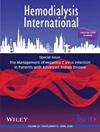Hemodialysis Nonattendance: Patient Characteristics and Outcomes in a Single Renal Center in North West England
Abstract
Introduction
Nonattendance for prescribed hemodialysis (HD) sessions is a form of nonadherence that compromises the delivery of life-sustaining HD therapy and is associated with severe morbidity and mortality. In this study, we aimed to assess the characteristics and outcomes of HD nonattenders in a single renal center in the North West of England.
Methods
HD patients followed by the renal team at our unit between December 2020 and September 2022 were included in this study. Dialysis nonattendance data were retrieved from the incident reports (DATIX) between December 2020 and November 2022, excluding dialysis nonattendance due to concurrent hospitalization. The cohort was split into group 1: no dialysis nonattendance; group 2: two or fewer dialysis nonattendances; and group 3: more than two dialysis nonattendances for comparative analysis. All patients were followed up for outcomes including all-cause mortality, transplantation, and hospitalizations until the study endpoint date of 12/31/2023. Predictors of dialysis nonattendance were identified using logistic regression.
Results
Of the 464 patients, dialysis nonattendance was noted in 149 (32%) patients, of which 79 (17%) had two dialysis nonattendance episodes and 70 (15%) had more than two dialysis nonattendance episodes. Over a median follow-up of 35 months, patients in group 3 had a higher hospitalization episode (4 vs. 1 day, p < 0.001) and lower kidney transplantation rates (4.3% vs. 13%, p = 0.038) compared to patients in group 1. In multivariate regression analysis, younger age (OR: 0.97; 95% CI: 0.95–0.98; p = 0.001), history of smoking (OR: 2.01; 95% CI: 1.12–3.62; p = 0.019), alcohol excess history (OR: 3.49; 95% CI: 1.87–6.49; p < 0.001) and history of mental health illness (OR: 3.01; 95% CI: 1.61–5.62; p = 0.001) were significant predictors of dialysis nonattendance.
Conclusion
Skipping HD is a common phenomenon associated with mental health issues and is associated with increased morbidity. Further research is required to understand the psychosocial determinants of nonadherence and effective models of intervention developed to improve outcomes.


 求助内容:
求助内容: 应助结果提醒方式:
应助结果提醒方式:


